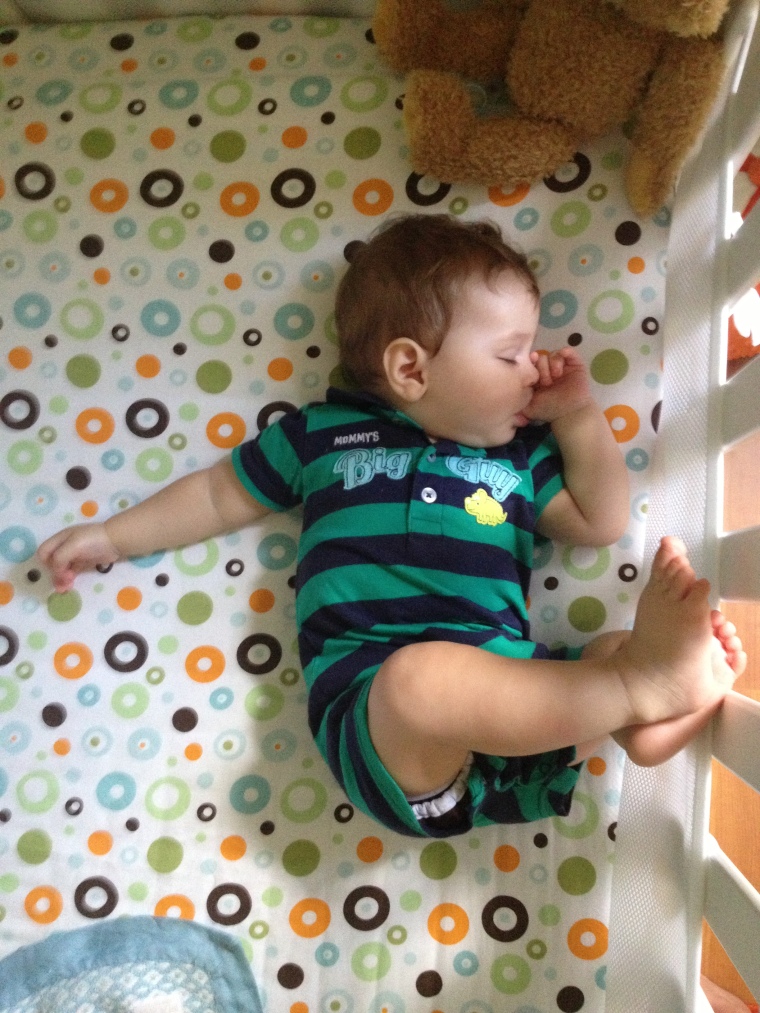
Sleep training is definitely a hot button topic. Whether you’re all for sleep training or adamantly against it, you’ve probably felt judged at some point, which leaves you feeling like you have to defend your decision to some parent who is in the other camp.
If you’ve been reading my blog a while, you know that I’m pro sleep training but I don’t believe that it is right for every family. I’ve always said that if what you’re doing is working for you, then by all means continue. If you’re happy and the baby is happy and you aren’t walking around like a zombie from lack of sleep then go about your business. But if you’re miserable, cranky and at your wits end, then perhaps sleep training is something you may want to look into.
There are a lot of misconceptions out there about sleep training. Allow me to go over some of the ones I’ve encountered:
MYTH: All methods of sleep training involve letting your child cry. FACT: This simply isn’t true. There are a variety of methods and some of them don’t involve crying.
MYTH: The methods that do involve crying, require you to leave your child in their room until they either cry themselves to sleep or throw up from screaming so much. FACT: I have literally never encountered a sleep training method that involved putting your baby to bed and leaving and not going back in no matter how long they cry. This, to me is neglect. The methods that involve crying, have the parents going back in frequently to check on and reassure the baby.
MYTH: Letting your baby cry causes brain damage. FACT: This isn’t true. Severe neglect in infants leads to their brains not developing the way they should, but allowing them to cry while they learn to self sooth, is in no way going to lead to brain damage. (1)
MYTH: Sleep training will alter your baby’s personality or lead to personality disorders later in life. FACT: There hasn’t been any research to back this up. In fact, if your child is sleeping better and more rested they are likely to be much more pleasant and cheerful, then they would otherwise be, which in turn leads to an increase in family well-being. (1)
MYTH: Sleep training increases the risk of Sudden Infant Death Syndrome (SIDS). FACT: Sleep training has not been linked to SIDS, however bed sharing/co-sleeping has and I did a whole post about that, which can be found here.
So now that we have debunked some myths, I will say that not all sleep training methods are suitable for all children. You have to find the one that works best for your family. The Journal of Sleep did a review of the 52 best sleep studies and found that there were no differences in the effectiveness in the leading sleep training methods and furthermore none of the studies identified adverse secondary effects of participating in a sleep training program. (1) With that said however, there will always be instances where sleep training could be harmful. The following except from a developmental psychologist and one of the authors of the book Bedtiming, addresses this issue:
“It depends because some kids are particularly sensitive to separations; it depends because parents can get so resentful of failed attempts at sleep training that they treat the child poorly and that, in turn, has detrimental effects (and we can’t tease apart these effects from the amount of crying the child is doing); it depends because some children’s crying, even the most minimal amounts, sends some vulnerable women into a tailspin of postpartum depression and we know that’s not good for kids in the long run; it depends because some children become physiologically so aroused when they cry that they vomit or hyperventilate and, well, that’s not good for some kids either; it depends because some children cry MORE when they’re being rocked to sleep by well-intentioned parents than they would if they were left alone and ignoring that need that some kids have to be left alone (which they can’t articulate) may actually be equally detrimental to some kids; it depends because many couples go through significant marital conflict when it comes to deciding how long to let their baby cry and marital conflict has repeatedly and consistently been found to have long-term negative consequences for children. So… how would you tease out whether it was the length of crying during sleep training or the marital conflict about the crying that made the biggest dent in a child’s developmental outcomes? (You COULD do it, but the study would be very complex and it hasn’t been conducted yet). So, yeah, it depends (and I could go on for much longer about all the factors that make this seemingly simple question so very, very complex).” (2)
Baring abnormal circumstances, sleep training of any form is actually beneficial. (1) This, article by Rachel from My Baby Sleep Guide, does a really good job at summarizing the previous research around what is arguably the most controversial form of sleep training; The Cry It Out Method.
So as you can see, the research shows that sleep training isn’t detrimental however, that doesn’t mean that every single parent should sleep train. Every parent needs to make this decision for themselves. If one method isn’t working for them, or they think it’s having a negative effect on their child, then they should stop, take a break and try something else. No matter what you or anyone decides, there shouldn’t be any judgement involved. Parenting is hard enough, without also being judged by some other parent that thinks they know what’s best for your family and your child. My advice is this; even if you adamantly disagree with someone else’s parenting choice, you should just agree to disagree and support each other in your decisions.


